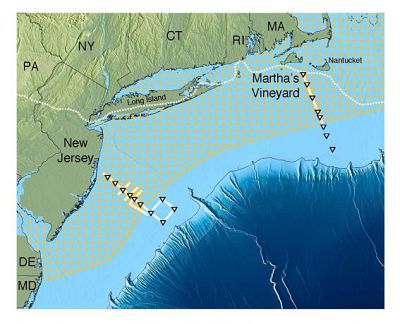If similar reservoirs exist in other coastal areas, they could be valuable resources for water-starved regions around the world.
A vast reservoir of relatively fresh water has been discovered locked within layers of porous rock beneath the Atlantic Ocean off the east coast of the U.S. The remarkable discovery suggests that similar undersea aquifers could exist elsewhere in the world — potentially good news given the rise of water shortages like the one now affecting the Indian city of Chennai.
The newfound aquifer spans about 15,000 square miles, stretching from New Jersey out beyond Martha's Vineyard, and is thought to hold about 670 cubic miles of brackish water. That's equivalent to more than half the total volume of Lake Michigan, according to Chloe Gustafson, a doctoral student at Columbia University's Lamont-Doherty Earth Observatory and the leader of the survey that revealed the aquifer.
"It's important to remember, though, that these aren't open caverns or lakes underneath the seafloor," Gustafson said. "This is water trapped within the pores of rocks, so it's sort of like a water-soaked sponge."
The research was published June 18 in the journal Scientific Reports.
Gustafson said scientists had known since the 1970s that a vast formation like the one the researchers found could exist off the east coast, after companies drilling for offshore oil found evidence of fresh water deposits nearby. But the new survey is the first to establish the aquifer's size and map it in detail.
Gustafson and her colleagues mapped the subsea aquifer by measuring electromagnetic fields below the coastal region. They dropped receivers to the seafloor and used a ship to tow an apparatus that emitted electromagnetic pulses. Since saltwater conducts electromagnetic waves better than fresh water, the researchers could pinpoint the aquifer based on the fields produced beneath the seafloor.
"The underlying principle comes from high school physics, where you stick a magnet through a loop of wire to induce a current and voltage through that wire," Gustafson said. "That creates an electric field and secondary magnetic field. We used those same principles and just scaled them up."
Environment
The research showed that the deposits of the relatively fresh water start at the shoreline and extend out as far as 75 miles, near the edge of the continental shelf, Gustafson said. The water lies about 600 feet beneath the seafloor, with the deepest sections of the aquifer extending down to about 1,200 feet.
The newfound aquifer and others like it could represent an important resource, especially for water-starved regions, said Andrew Fisher, a professor of physical and biological sciences at the University of California, Santa Cruz. Hints of fresh water springs coming from below the seafloor have been found off the coasts of California, South Carolina and Greenland, and future studies could identify subsea aquifers in other coastal regions.
Extracting the water locked in the rock layers and treating it to make it potable would likely be costly and possibly impractical, Fisher added — though he said it might be a reasonable option in parts of the world facing crippling water shortages.
"When communities are faced with no other choices except the expensive ones, then the expensive choices start looking alright," Fisher said. "We're seeing more and more communities looking for ways to secure fresh water."
Others doubt the long-term feasibility of tapping subsea reservoirs.
"There's a limit to how much you can pump sustainably," said Graham Fogg, a professor of hydrogeology at the University of California, Davis. "It would take a long time to empty these aquifers, but we wouldn't want to get to a point where we've pumped so much that we've exhausted the supply."
But Fogg and Fisher, neither of whom was involved in the discovery of the aquifer, praised the researchers for pioneering a way to find such reservoirs. "I think it's exciting that we now have these tools that can help us map out water resources over a large area," Fisher said. "It's a really terrific study."
Want more stories about the environment?
- Your clothes are secretly polluting the environment. Here's why you should be concerned.
- Without swift action on climate change, heat waves could kill thousands in U.S. cities
- Disturbing survey reveals 414 million pieces of plastic debris on remote islands
SIGN UP FOR THE MACH NEWSLETTER AND FOLLOW NBC NEWS MACH ON TWITTER, FACEBOOK, AND INSTAGRAM.












